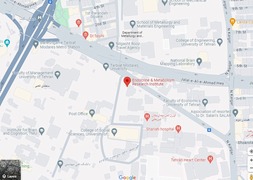- 1404/08/04 Cost‑effectiveness analysis of fracture liaison services in Iran
- 1404/07/14 Evaluation of bone mineral density and its influencing factors in patients infected with HIV under antiretroviral therapy
- 1404/05/12 Association between serum hemoglobin level and bone mineral density in adults Iranian multi center osteoporosis study IMOS
- 1404/03/21 Endocrinology and Metabolism Research Institute Signs MOU with Dairy Industry Association to Promote Bone Health
- 1403/09/01 Osteoporosis Updates Seminar: Advancing Prevention, Diagnosis, and Treatment
- 1403/07/04 Holding the World Congress on Osteoporosis and Musculoskeletal Diseases hosted by the International Osteoporosis Foundation
- 1403/07/04 Imam Khomeini Hospital in Sari Recognized as a Global Leader in Fracture Prevention

Introduction to the Center
The Osteoporosis Research Center was initially established as the Osteoporosis Research Group in 1999 within the Endocrinology and Metabolism Research Center at Tehran University of Medical Sciences. Over the past decade, with the support of skilled faculty members and researchers, extensive studies have been conducted on osteoporosis, the most common bone disease in the country. Following significant research and efforts by this group, the Osteoporosis Research Center was officially recognized as part of the Endocrinology and Metabolism Research Institute of Tehran University of Medical Sciences and resumed its activities as a recognized research center in May 2010.
Among the most notable initiatives of this center is the implementation of a comprehensive nationwide osteoporosis prevention, diagnosis, and treatment program. This multi-center project, in collaboration with the Ministry of Health and Medical Education and five research centers from universities across the country (Tehran, Shiraz, Mashhad, Tabriz, and Bushehr), assessed bone mineral density (BMD) and serum vitamin D levels (a crucial factor influencing bone density) along with other factors affecting bone health in over 6,000 Iranian adults, making it the largest research project of its kind in the Middle East. One of the significant outcomes of this project was the establishment of the Osteoporosis Research Network in Iran, facilitating close collaboration and communication among officials, professors, and researchers involved in the comprehensive osteoporosis program nationwide.
Initially designed to be implemented in five main regions, this network has now expanded to more areas across the country. The network's efforts include pursuing the initial objectives of the comprehensive program, monitoring the disease in these regions, providing treatment solutions to healthcare systems and the public, and expanding research areas in line with global research efforts on osteoporosis.
Another significant achievement of the center is the development and implementation of the "Vitamin D Fortification of Foods Program," aimed at preventing and treating vitamin D deficiency, which is a contributing factor to osteoporosis in children and adolescents.
The center, with its two departments for bone density measurement and osteoporosis clinics, strives to provide the best services for patients with osteoporosis in the country, in addition to its clinical and research efforts in the field.
Education is another crucial aspect of the center's activities. To this end, comprehensive meetings and seminars have been organized for the general public and healthcare professionals. A range of pamphlets, brochures, and clinical guides for patients and doctors have also been prepared and made available.
Given the prevalence and significance of osteoporosis in the country, efforts have been made to address the challenges faced by osteoporosis patients by establishing the Osteoporosis Association. Additionally, the launch of an international osteoporosis journal represents another step towards advancing knowledge about this disease. Membership in the International Osteoporosis Foundation (IOF) and establishing scientific connections with international organizations and centers involved in osteoporosis research and clinical activities are among the center's other achievements.
It is hoped that the center will continue to make strides in improving public health and advancing knowledge.



